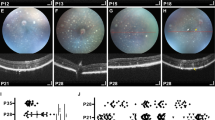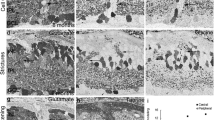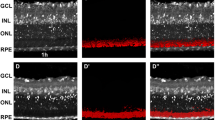Abstract
Purpose
To examine the ultrastructure of the adult rd mouse retina in order to determine what structures are altered or lost and thus to better interpret changes produced by photoreceptor and/or retinal transplantation in this model of retinal degeneration.
Methods
rd mutant mice expressing a LacZ reporter gene in rod bipolars were used in order to identify these cells and their processes. Mice of age 6 weeks to 5 months were studied by electron microscopy, concentrating on the posterior pole where retinal transplants are usually placed.
Results
The adult rd mouse retina contains degenerating cones, cone outer segments, cone synaptic pedicles with synaptic vesicles and post-synaptic contacts. The major abnormalities occur in the subretinal space where all traces of rods are gone and the main structures are inner segments of cones. These inner segments are smaller than normal, contain fewer and smaller mitochondria, have organized arrays of microtubules, resembling those in cone axonal processes, and are completely engulfed by massive proliferation of apical processes of the retinal epithelium. The subretinal space is well defined by the external limiting membrane vitreally and the retinal epithelium choroidally. Muller cells extend globular rather than filamentous processes into the subretinal space which contact the apical processes of the epithelium. Rod bipolar cells survive and retain processes in the external plexiform layer.
Conclusions
The adult rd mouse retains structural elements necessary for phototransduction and transmission of signals to the inner layers of the retina by the cone system. The major deficits are located in the subretinal space where all rods are lost and cone inner segments undergo a slow degeneration. Rod bipolar cells survive but appear to be de-afferented; there was no evidence that they contact residual cone processes in the external plexiform layer. The rd mouse is a logical model to study the effects of transplantation of photoreceptors because second- and third-order retinal neurons as well as degenerating cones survive in the adult retina.






Similar content being viewed by others
References
Blanks J, Adinolfi A, Lolley R (1974) Photoreceptor degeneration and synaptogenesis in retinal degenerative (rd) mice. J Comp Neurol 156:95–106
Blanks JC, Johnson LV, Hoffman M (1983) Lectin probes detect abnormal vasculature in mice with inherited photoreceptor degeneration. Invest Ophthalmol Vis Sci 24 [Suppl]:115
Caley DW, Johnson C, Liebelt RA (1972) The post-natal development of the retina in the normal and rodless CBA mouse: a light and electron microscopic study. Am J Anat 133:179–212
Carter-Dawson LD, LaVail MM, Sidman RL (1978) Differential effect of the rd mutation on rods and cones in the mouse retina. Invest Ophthalmol Vis Sci 17:489–491
Garcia-Fernandez JM, Jiminez AJ, Foster RG (1995) The persistence of cone photoreceptors within the dorsal retina of the aged retinally degenerate mice (rd/rd). Neurosci Lett 187:33–36
Gouras P, Tanabe T (2003) Survival and integration of retinal transplants in rd mice. DOI 10.1007/s00417-003-0648
Gouras P, Du J, Kjeldbye H, Kwun R, Lopez R, Zack DJ (1991) Transplanted photoreceptors identified in dystrophic mouse retina by a transgenic reporter gene. Invest Ophthalmol Vis Sci 32:3167–3174
Gouras P, Du J, Kjedblye H, Yamamoto S, Zack DJ (1992) Reconstruction of degenerate rd mouse retina by transplantation of transgenic photoreceptors. Invest Ophthalmol Vis Sci 33:2579–2586
Gouras P, Du J, Kjeldbye H, Yamamoto S, Zack DJ (1994) Long-term photoreceptor transplants in dystrophic and normal mouse retina. Invest Ophthalmol Vis Sci 35:3145–3153
Karli P, Stoeckel MD, Porte A (1965) Degenerescence des cellules visuelles photo-receptrices d'un sensibilite de la retine a la stimulation photique. Observations au microscopic electronique. Z Zellforsch Mikrosk Anat 65:238–252
Kuwabara T (1965) Microtubules in the retina. In: Rohen JW (ed) Eye Structure II. Symposium. Schattauer, Stuttgart, pp 69–84
Kwan AS, Wang S, Lund RD (1999) Photoreceptor layer reconstruction in a rodent model of retinal degeneration. Exp Neurol 159:21–33
Lasansky A, de Robertis E (1960) Submicroscopic analysis of the genetic dystrophy of visual cells in C3H mice. J Biophys Biochem Cytol 7:679–683
Lewis GP, Fisher SK (2000) Muller cell outgrowth after retinal detachment: association with cone photoreceptors. Invest Ophthalmol Vis Sci 41:1542–1545
Lund RD, Kwan ASL, Keegan DJ, Sauve Y, Coffey PJ, Lawrence JM (2001) Cell transplantation as a treatment for retinal disease. Prog Ret Eye Res 20:415–449
Mata NL, Radu RA, Clemmons RS, Travis GH (2002) Isomerization and oxidation of vitamin A in cone dominant retinas: a novel pathway for visual pigment regeneration in daylight. Neuron 36:68–80
Mathes MT, Bok D (1984) Blood vascular abnormalities in the degenerative mouse retina (C57BL/6J-rd le) Invest Ophthalmol Vis Sci 25:364–369
McLaughlin ME, Ehrhart TL, Berson EL, Dryja TP (1993) Mutation spectrum of the gene encoding the beta subunit of rod phosphodiesterase among patients with autosomal recessive retinitis pigmentosa. Proc Natl Acad Sci USA 92:3249–3253
Milam AH, Li ZY, Fariss RN (1998) Histopathology of the human retina in retinitis pigmentosa. Prog Ret Eye Res 17:175–205
Neuhardt TH, May CA, Wilsch C, Eichorn M, Lutjen-Drecoll E (1999) Morphological changes of retinal pigment epithelium and choroids in rd-mice. Exp Eye Res 68:75–83
Oberdick J, Smeyne RJ, Mann JF, Zackson S, Morgan JI (1990) A promoter that drives transgene expression in cerebellar Purkinje cells and retinal bipolar neurons. Science 248:223–226
Radner W, Sadda SR, Humayun MS, Suzuki S, Weiland J, deJuan E (2001) Light driven retinal ganglion cell responses in blind rd-mice after neural retinal transplantation. Invest Ophthalmol Vis Sci 42:1057–1065
Ripps H (2002) Cell death in retinitis pigmentosa: Gap junctions and the "Bystander" effect. Exp Eye Res 74:327–336
Robb RM (1974) Electron microscopic histochemical studies of cyclic 3', 5'-nucleotide phosphodiesterase in the developing retina of normal mice and mice with hereditary degeneration. Trans Am Ophthalmol Soc 72:650–669
Sanyal S, Bal AK (1973) Comparative light and electron microscopic study of retinal histogenesis in normal and rd mutant mice. Z Anat Entwicklungsgesch 142:219–238
Shiose Y (1968) Electron microscopic aspects of inherited dystrophic mouse retina. Jap J Ophthalmol 12:181–190
Sinoj K, Smith JE, Aguirre GD, Milam AH (2000) Loss of cone molecular markers in rhodopsin mutant human retinas with retinitis pigmentosa. Mol Vision 6:204–215
Wang S, Villegas-Perez M, Vidal-Sanz M, Lund RD (2000) Progressive optic axon dystrophy and vascular changes in rd mice. Invest Ophthalmol Vis Sci 41:537–545
Author information
Authors and Affiliations
Corresponding author
Rights and permissions
About this article
Cite this article
Gouras, P., Tanabe, T. Ultrastructure of adult rd mouse retina. Graefe's Arch Clin Exp Ophthalmol 241, 410–417 (2003). https://doi.org/10.1007/s00417-003-0649-1
Received:
Revised:
Accepted:
Published:
Issue Date:
DOI: https://doi.org/10.1007/s00417-003-0649-1




